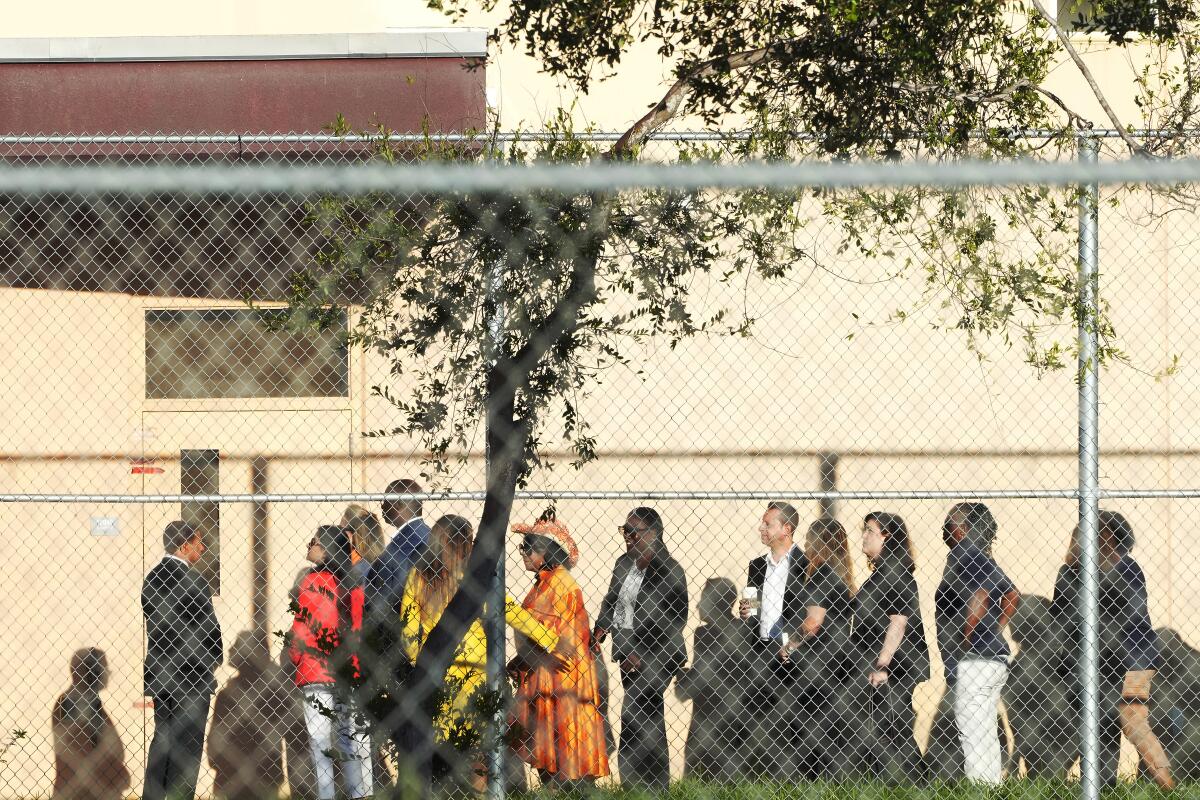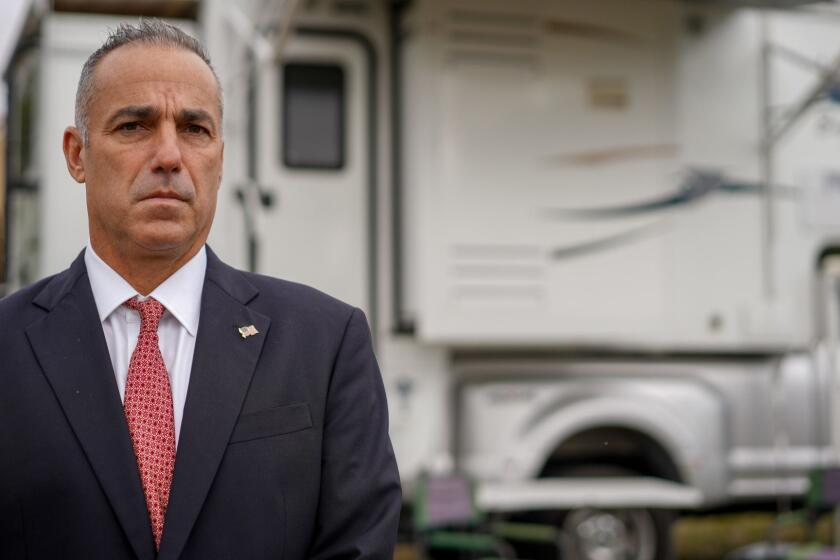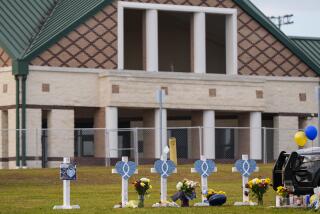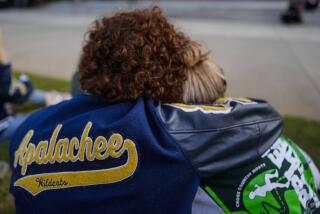Shots again fired at site of Parkland school massacre in reenactment after lawmakers visit

- Share via
PARKLAND, Fla. — Gunfire erupted again at Marjory Stoneman Douglas High School in Parkland, Fla., on Friday as part of a reenactment by ballistics experts of the 2018 massacre that left 14 students and three staff members dead.
Two shots were heard by reporters sitting about 200 yards from the building about noon and then two more about an hour later. A few hours later, the fire alarm went off, just like it did during the Valentine’s Day 2018 attack, but no shots were heard underneath it. During the massacre, 139 shots were fired.
The reenactment is part of a lawsuit by the victims’ families and the wounded that accuses the Broward County deputy assigned to the school of failing in his duty to protect the students.
David Brill, the attorney overseeing the reenactment on behalf of the families, did not return a call seeking comment Friday, so it was unknown whether only four shots were needed for the test or if a problem developed and it had to be aborted.
The reenactment began shortly after nine members of Congress toured the blood-stained and bullet-pocked halls of the three-story classroom building where Nikolas Cruz carried out his six-minute attack. The building has been kept standing behind a locked chain-link fence to serve as evidence during Cruz’s trial last year.
The shooting sparked a nationwide movement for gun control and traumatized the south Florida community. Cruz, a former Stoneman Douglas student who is now 24, pleaded guilty in 2021 and was sentenced to life in prison.
The experts were firing with an AR-15-style semiautomatic rifle identical to the one Cruz used, and the bullets were to be caught by a safety device.
Andrew Pollack had just settled into a folding chair in a palm-shaded campground when gunfire rang out from a nearby target range.
Brill said in earlier court hearings that the reenactment’s goal was to capture what Deputy Scot Peterson heard during the attack.
Peterson, who worked for the Broward County Sheriff’s Office and is named in the lawsuit, said he didn’t hear all the shots and could not pinpoint their origin because of echoes. He got within feet of the building’s door and drew his gun, but backed away and stood next to an adjoining building for 40 minutes, making radio calls. He has said he would have charged into the building if he had known the shooter’s location.
Surveillance footage released by Florida authorities Thursday appears to show a Broward County deputy waiting outside Marjory Stoneman Douglas High School for several minutes, speaking on his radio, as a mass shooting unfolded inside.
Families of the victims who filed the lawsuit contend that Peterson knew Cruz’s location, but retreated out of cowardice and in violation of his duty to protect their loved ones.
Peterson, 60, was acquitted in June of felony child neglect and other criminal charges for failing to act, the first U.S. trial of a law enforcement officer for conduct during an on-campus shooting.
The burden of proof is lower in the civil lawsuit. Circuit Judge Carol-Lisa Phillips allowed the reenactment, but made clear she was not ruling on whether the recording will be played at trial. That will have to be argued later, she said. It is likely Peterson’s attorneys will oppose the attempt.
No trial date has been set. The families and wounded are seeking unspecified damages.
A newly released timeline of law enforcement operations at the deadly Florida mass shooting last month indicates a school resource officer lingered outside the high school, failed to confront the shooter and ordered fellow officers to stay back from the building where the shots were heard.
Earlier in the day, six Democrats and three Republicans from the House School Safety and Security Caucus toured the building for almost two hours — an experience few have had since the shooting. They called it a “time-capsule” of the attack’s devastation.
Broken glass still litters the floor, along with wilted roses, deflated balloons and discarded gifts. Opened textbooks and laptop computers remain on students’ desks — at least those that weren’t toppled during the chaos.
In one classroom, there is an unfinished chess game one of the slain students had been playing, the pieces unmoved. Reporters were barred from Friday’s tour, but the Associated Press was one of five media outlets allowed to tour the building after Cruz‘s jury went through last year.
“We just had a shared experience that will transform our lives for the rest of our lives. To see the blood of children on the floor in a school together is going to change the way we interact and collaborate,” New York Democratic Rep. Jamaal Bowman said.
After the tour, the members traveled to a nearby hotel to discuss school safety issues with parents and spouses who lost loved ones in the attack. The roundtable meeting was being held in the same ballroom where the families learned of their loved ones’ deaths.
The members said that while there is wide disagreement on issues such as gun control, there should be bipartisan support for providing federal funds for installing bulletproof glass and panic buttons in classrooms, mental health assistance for students and better training for on-campus police officers.
Florida Democratic Rep. Jared Moskowitz said Congress owes it to the families who have lost children, parents and spouses in school shootings to pass such measures and make campuses safer. He said seeing the scene allowed the members to fully grasp what happened.
“You can read about it all day long, and debate it all day long, but it is not the same as walking through the school,” said Moskowitz, who organized the tour with Republican Rep. Mario Diaz-Balart of Miami. Moskowitz pointed out that Parkland, an upscale suburb of Fort Lauderdale, is considered Florida’s safest city.
“It is now the home of the largest [high] school shooting in our history,” he said.
Diaz-Balart said that while touring the building, he was struck by how fast the lives were lost — all the fatalities happened within the attack’s first four minutes.
“The key is not just to come and see, the key is that we can put aside our differences, put aside the perfect and try to get some good things done. I am optimistic,” Diaz-Balart said.
The building is scheduled to be demolished soon, but the House members and families are hoping it can be kept up a bit longer so more state and federal legislators and White House advisors can also tour it.
Parent Max Schachter, whose 14-year-old son, Alex, died in the shooting, suggested the tour and school safety roundtable to Moskowitz.
“We can come together and enact commonsense school safety solutions so this will never happen again,” said Schachter, a former insurance broker who is now a full-time campus safety advocate. “Safety has to come before education — you cannot teach dead kids.”
More to Read
Sign up for Essential California
The most important California stories and recommendations in your inbox every morning.
You may occasionally receive promotional content from the Los Angeles Times.











